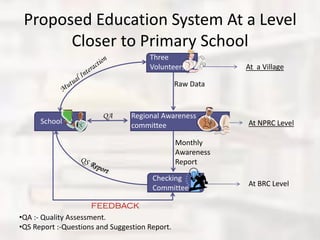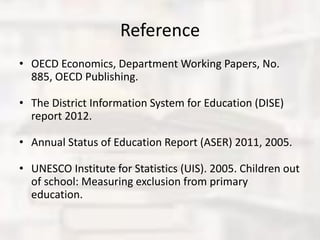AARYA-1
- 1. Manthan Topic: “Enhancing the quality of primary education ” Innovated by: • Kunwar Romendra Pratap Singh ,Third Semester , B.tech.(Civil) NIT Raipur • Manas Tripathi , Third Semester, B.tech.(Civil) NIT Raipur • Mayank Dubey , Third Semester, B.tech.(Civil) NIT Raipur • Snehil Pandey ,Third Semester, B.tech.(Mechanical) NIT Raipur • Vikrant Thakur ,Third Semester, B.tech.(Civil) NIT Raipur Primary education before you run, Know how to stand!
- 2. • Indian education system is considered to be the second largest in the world • It consists of nearly 610,000 primary schools with 1.87 million teachers and 110 million students • Latest educational Statistic indicates Gross Enrollment Ratio of 93.7%. • According to 2011 report of ASER , only 42.8% of students of 5th grade were able to read books of 2nd grade. • Although our education system claims it to be one of the largest but it cannot make similar claims for efficiency quality and achievements of students. 0 10 20 30 40 50 60 70 Read Solve Numerical Sums Government Schools Private School Graph :- Percentage of children in grade 2-5 who cannot read or solve numerical sums. According to Annual Status of Education Report (ASER) 2005 , Students from privately managed school perform better as compared to the students from government aided rural school.
- 3. 26% 23% 20% 17% 14% Population of Children in school Poorest Second Middle Fourth Richest 2000 2006 Change 2000 to 2006 Male 79.2 85.2 5.9 Female 72.3 81.4 9.1 Urban 82.5 88.5 5.9 Rural 73.8 81.5 7.7 Poorest 20% 66.1 69.4 3.2 Second 20% 69.2 81.2 12.1 Middle 20% 78.8 87.5 8.7 Fourth 20% 82.1 92.2 10.1 Richest 20% 89.1 95.7 6.6 Total 75.9 83.3 7.5 Data sources: India Multiple Indicator Cluster Survey (MICS) 2000, India DHS 2005-06. Table 1: Children of primary school age in school (percent), India 2000 and 2006.
- 4. Primary Education System In India DEO OFFICE BRC BRC NPRC NPRC NPRC NPRC School School School School School School School School V I L L A G E S•BRC :- BLOCK RESOURCRE CENTRE. •NPRC :- NYAY PANCHAYAT RESOURCE CENTRE. •DEO :- DISTRICT EDUCATIONAL OFFICER.
- 5. • The National Policy Education reiterated the urgency to address the quality concern in school education. • But quality cannot be improved by itself. • It requires better atmosphere , awareness of parents, better infrastructure and motivation to students. • Less burden on teachers i.e. less involvement in non teaching works such as volunteers in public related works. • Spreading the awareness among the parents concerned
- 6. Proposed Education System At a Level Closer to Primary School Three Volunteers School At a Village At NPRC Level At BRC Level Regional Awareness committee Checking Committee FEEDBACK Raw Data Monthly Awareness Report QA •QA :- Quality Assessment. •QS Report :-Questions and Suggestion Report.
- 7. Work assigned at each stage Volunteers • To aware the parents about the education of his /her child. • To collect data regarding the no. of students who did not attend the school ,with a valid reason. • To convey the message of the teacher regarding monthly parents teacher meet to the parents and encourage parents to attend these. • To know the response of students from their parents about the school. • And to submit these data to the Regional Awareness Committee each month. Regional Awareness Committee • To select volunteers from the school area itself. • To collect data from volunteers and submit it to checking committee • Prepare a proper report including the problems and the reasons regarding the school. • To check the progress of the school regarding the infrastructure of the school and assessment of the students. • To improve quality education of the students by visiting the school . Checking Committee • To analyze the report given by Regional Awareness Committee. • To enquire the schools on the basis of the report submitted by the checking committee. • To take actions on the wrong implementations of the policy. • To encourage the schools performing progressively. • To take feedback from the school and to match this feedback by the report of the Regional Awareness Committee. • To indicate the solutions for problems of the school to the teachers.
- 8. • Volunteers selected by the RAC will perform the survey work in a given span of time i.e. one month. • This survey report consist of the problems faced by the students and the teachers, a common feedback of the parents, and an attendance report of the students. • This raw data obtained by the volunteers will than be handed to the Regional Awareness Committee. • The RAC will do a detailed analysis of the raw data and makes a final report which consist of : 1. The main Problems of the school including shortage of Net Attendance Ratio(NAR) and Gross Enrolment Ratio and there possible reasons. 2. Progress in the quality of education, students performance and positive approach of teachers. • This analysed report is then sent to the Checking Committee where solution of all the possible problems are thought upon. • The solution report as well as problem report both are then send to the school ,a feedback must be send to the checking committee within ten days • Necessary action is taken , if a proper feedback is not obtained within ten days.
- 9. Eligibility Criteria and AuthorityVolunteers • Minimum: Intermediate qualified. • Age limit : 22- 35 Years • Selected by Regional Awareness Committee (Persons eligible for MNREGA) • They will work under teachers. • Accountable to RAC. RACMembers • Minimum Qualification : Graduate • Selection Criteria : personal Interview by Grade -I Officer. • They have control Over Volunteers. • They have authority to question school management, regarding academics. CCMembers • Retired Officers Equivalent to BEO*. • They have control over RAC . • The also have authority to ask and suggest ,the school management according to the report submitted by RAC. • They are accountable to DEO. *BEO :- Block Educational Officer No. of Committee (Regional and Checking) members may vary from place to place according to the need.
- 10. •No. of volunteers is three for each area. •Volunteers will be paid according to MNREGA for rural area and state funded in urban areas. •Each person will be paid Rs. 1000 per month. Volunteers •Four to five members in each committee. •They will be paid Rs. 15000/- per month by State Government. •Estimated cost Rs. 21.5 Crore per annum. RAC Members •Three to Four members in each committee. •They will be paid Rs. 20000/- per month by State Government. •Estimated cost Rs. 2.2 Crore Per annum. CC Members Estimated costs are given for a state on average. Total Fund : Rs. 25-30 Crore
- 11. Advantages • Parents will be more aware about the importance of the primary education. • Mentality of Students , Parents and Teachers would change from not just attending the classes but also learning in the classes. • Teachers will be more regular and responsible • Less burden on the teachers thus allowing them to concentrate on the students even more. • Frequent Parent Teacher Meet will help to know the progress of the student , problems concerning them. • Regular survey of this system will help to provide hobby oriented classes. • It will also help us to know the plight of the students who are interested and are not able to enroll themselves in the school. • Our proposed education system will have an optimistic approach toward the welfare of the students. • Those who claimed MNERGA allowance without putting in some work would have to earn their livings. Challenges and Risks • Non Cooperative parents may cause problems. • Proper Funding is required at each stages. • Corruption is root to all the problems so a corruption free committee is must.
- 12. Reference • OECD Economics, Department Working Papers, No. 885, OECD Publishing. • The District Information System for Education (DISE) report 2012. • Annual Status of Education Report (ASER) 2011, 2005. • UNESCO Institute for Statistics (UIS). 2005. Children out of school: Measuring exclusion from primary education.











